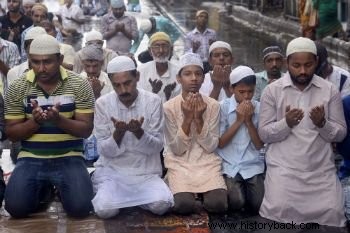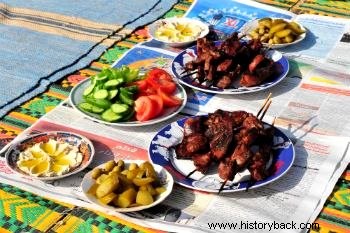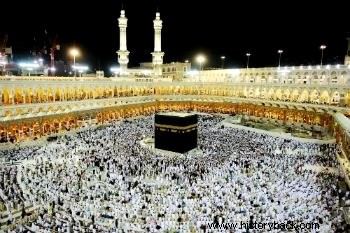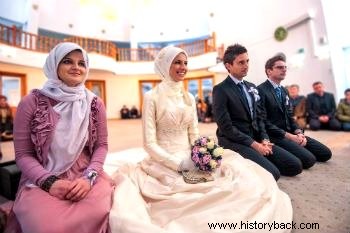The Muslim Culture or Islamic is as heterogeneous as the number of peoples who maintain it, especially in regions of Africa and Asia.
However, she shares aspects that pertain to the Islamic religion. It is important to note that the word “Muslim” itself derives from Arabic (“aslama ”) and means “submitted to God.”
 Muslim Men Praying
Muslim Men Praying
Therefore, every Muslim is a subject converted to Islam (from Arabic, “surrender ”). Therefore, the terms “Muslim culture” and “Islamic culture” are confused, since those aspects influence dimensions of the moral and political life of Muslim society.
Characteristics of Muslim Culture
Originally, the Muslim culture took place among the Semitic herdsmen of the different tribes that were brought together by the Prophet Muhammad.
After his death in 632, Arabia was unified and the expansion of the Arab Empire began. He was fully grounded in the precepts of Islam being led by a caliph.
The sociopolitical system indicated by the prophet and written in the holy books of the Muslim religion spread throughout the Mediterranean, Red and Indian Ocean seas.
There, they established great trade routes. Furthermore, the Mohammedan culture in formation met the Byzantine, Persian, Chinese and Indian cultures, assimilating their cultural aspects while preserving the customs and beliefs of the conquered peoples.
On the other hand, it is worth noting that Muslims are divided between Sunnis and Shiites .
The Sunnis follow the teachings of the Qur'an (or Koran) and the Suna. They were led by All-Abbas, uncle of the Prophet Muhammad after his death.
The Shiitas , are followers of Ali, son-in-law of Muhammad, and use the Koran solely as a form of sociopolitical guidance.
Then we can point to “Sharia ”, the set of laws based on holy scriptures such as the “Muslim law book” and the guide to behavior.
In this system, legal documents are less important than the spoken word, which is just as important as social status.
Originally, Muslims excelled in agriculture, with their irrigation techniques to produce cotton, cereals and oranges. In addition to it, manufactures for the production of cotton fabrics, glass artifacts and steel manufacturing stand out.
Another highlight goes to the Muslim architecture, responsible for the creation of magnificent palaces, mosques and schools. The Byzantine and Persian influence stand out, with their domes, minarets and twisted columns decorated with arabesques.
From a scientific and cultural point of view, Muslims were responsible for the preservation and diffusion of Hellenic culture. They thus allowed the Greek legacy to benefit Western European culture.
Likewise, Muslim mathematicians created the Hindu-Arabic numeral system. They contributed to the evolution of trigonometry and algebra, just as their physicists made important contributions to the studies of refraction of light and optics.
Its chemists discovered nitric and sulfuric acids, silver nitrate, sodium carbonate and the distillation, filtration and sublimation processes that allowed them to produce alcohol.
His doctors carried out important studies to unravel the causes of tuberculosis.
In philosophy, the philosophers Aristotle and Plato had a lot of influence. In literature, the best-known works in the Western world are “The Thousand and One Nights ”, “The Mines of King Solomon ” and “Ali Baba and the forty thieves ”.
Another very important aspect about Muslim culture is the “Ramadan ” (or Ramadan).
This law determines spiritual incitement in a certain month of the year (ninth month of the Islamic calendar) and fasting that prohibits the consumption of food or water before sunset.
Cooking
 Muslim Cuisine
Muslim Cuisine
At the outset, it is worth noting that some foods and drinks are prohibited by Muslim culture. Examples include alcoholic beverages and pork, as well as animals killed by natural causes or by other wild animals.
Therefore, the basis of the diet is composed of meat from fish, poultry, goats, cattle, camels and sheep. They are served baked or fried and seasoned with oriental spices.
Muslim food is served with bread (Pita bread), and eaten with grains, vegetables, and dried fruits.
The most popular dishes are rice with chicken, tabulem, raw or fried kibbehs, combs and chickpea paste (hummus ), eggplant and curd.
It is worth noting that in Muslim culture these foods are eaten with the hands (always with the right hand).
Religion
 Pilgrimage to Mecca
Pilgrimage to Mecca
The religion that guides Muslim culture is Islam. It is monotheistic and its most important holy book is the "Quran", written by Mohammed, considered by Muslims to be the last prophet of God.
Thus, Mohammedans are required to declare their faith, five daily prayers, charity, fast during the holy month of Ramadan and make a pilgrimage to the holy city of Mecca.
Marriage
 Muslim Wedding in Mosque
Muslim Wedding in Mosque
The Muslim wedding differs in each region in which it is celebrated. It is characterized, as a rule, as a contract in which the payment of a value is foreseen to the family of the groom who is looking for the bride and must accept the offer of the father of the bride.
Furthermore, we have to point out that Muslim laws allow a man to have up to four wives and that only men can marry outside their religion.
Women
 Muslim Woman Praying in Mosque
Muslim Woman Praying in Mosque
In Muslim culture, the differences between men and women are clear with regard to the roles, rights and duties of each gender.
Thus, in most Muslim countries, women have full religious rights to decide about marriage, divorce, dress and education.
However, in others, they deal with restrictions to determine their marital status, study and work, since they owe allegiance to men.
Therefore, it is common for Muslim culture to allow husbands to beat wives and force them to dress modestly.
As an example, we have Iran and Saudi Arabia, where women must cover their heads in public or wear a burqa.
Muslim Culture Today
Currently the majority of Muslims inhabit Asia and Africa, where the largest Muslim populations are found:
- Indonesia (184 Million);
- Bangladesh (119 Million);
- Pakistan (116 Million);
- Turkey (67 Million);
- Iran (56 Million);
- Egypt (48 Million).
At the same time, the Islamic religion which is the pillar of Muslim culture is the fastest growing in the world. It is already the second most important religion on the planet, with more than 50 Muslim-majority countries and more than 1.57 billion people in 2009.
Read Also :
- Middle East
- Arab Culture
- Spain
- Osama bin Laden
